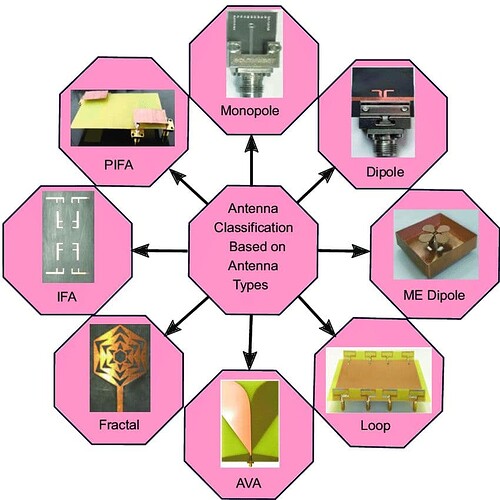There are many different types of antennas that can be used in 5G networks. The specific type of antenna that is used will vary depending on the frequency band, the application, and the environment.
-
Patch antenna: Patch antennas are typically made of metal and are printed on a flat surface. They are relatively inexpensive and easy to manufacture, and they can be used in a variety of frequency bands. Patch antennas are often used in mobile devices, such as smartphones and tablets, because they are small and lightweight.
- Merits: Inexpensive, easy to manufacture, can be used in a variety of frequency bands.
Demerits: Not as directional as some other types of antennas.
- Merits: Inexpensive, easy to manufacture, can be used in a variety of frequency bands.
-
Dipole antenna: Dipole antennas are simple, two-element antennas that are typically made of metal rods. They are efficient and have a wide bandwidth, but they are not as directional as some other types of antennas. Dipole antennas are often used in base stations and other fixed wireless applications.
- Merits: Efficient, has a wide bandwidth.
Demerits: Not as directional as some other types of antennas.
- Merits: Efficient, has a wide bandwidth.
-
Yagi antenna: Yagi antennas are directional antennas that are typically made of metal rods. They are more directional than dipole antennas, and they can be used to focus the signal in a particular direction. Yagi antennas are often used in point-to-point wireless links, such as between a base station and a cell phone tower.
- Merits: More directional than dipole antennas, can be used to focus the signal in a particular direction.
Demerits: Requires more elements than a dipole antenna, which makes it more expensive.
- Merits: More directional than dipole antennas, can be used to focus the signal in a particular direction.
-
Log-periodic antenna: Log-periodic antennas are directional antennas that are typically made of metal rods. They are more directional than Yagi antennas, and they can be used to cover a wide range of frequencies. Log-periodic antennas are often used in satellite communications and other applications where a wide range of frequencies is required.
- Merits: More directional than Yagi antennas, can be used to cover a wide range of frequencies.
Demerits: Requires more elements than a Yagi antenna, which makes it more expensive.
- Merits: More directional than Yagi antennas, can be used to cover a wide range of frequencies.
-
Array antenna: Array antennas are collections of multiple antennas that are arranged in a specific pattern. Array antennas can be used to improve the performance of the antenna, such as by increasing the gain or the directivity. Array antennas are often used in base stations and other fixed wireless applications where high performance is required.
- Merits: Can be used to improve the performance of the antenna, such as by increasing the gain or the directivity.
Demerits: More complex and expensive than other types of antennas.
- Merits: Can be used to improve the performance of the antenna, such as by increasing the gain or the directivity.
LinkedIn: ![]()
